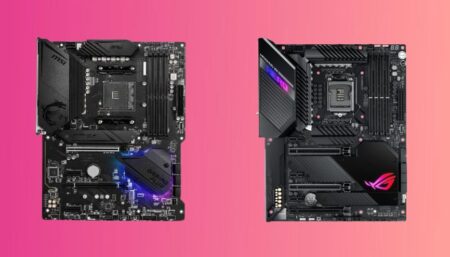![How to Test Motherboard without CPU? 4 Methods [2024]](https://www.ingameloop.com/wp-content/uploads/How-to-Test-Motherboard-without-CPU.jpg)
The motherboard is an integral part of your PC since it lets us connect most of the system components in one spot. You would be true if you call it the backbone of a computer. It helps different parts of the computer communicate with each other and effectively transfer their data. If the motherboard doesn’t work as intended, your other components won’t work correctly either. Therefore, you must focus on this component’s utility, usage, and operational health, so you don’t face any type of performance issues.
There may be various reasons to test your motherboard without the processor attached to it. Most people test their motherboard without the CPU installed because they are trying to figure out if it is dead or alive, which can sometimes be challenging to determine. Don’t worry since this article is helpful as it guides you on how to test motherboard without CPU. We have discussed a few easy-to-apply methods in this post that will help you troubleshoot your motherboard or test it without having a CPU attached.
Can we test motherboards without a CPU?
The short answer is yes. You can test the motherboard without the CPU, but only if it has some features as well. I’m talking about the POST (Power On Self Test), which lets you test your mobo using LED lights. However, there will be no display. But if your board doesn’t have this feature, some other methods can still help you with it. Although mobo testing without a CPU comes with some limitations, like you can’t run overclocking, audio, or video tests without installing a CPU, let’s make it easy!
How to test Motherboard without CPU?
The following are the easiest methods for motherboard testing without installing the CPU:
Method 1: Power-On-Self-Test (POST)
The power-on self-test is a wonderful feature provided by many modern motherboards. It lets you quickly test your motherboard without the CPU. In fact, this is a popular way to diagnose a problem with your motherboard to fix it. Below are the simple steps to perform a power-on self-test on your motherboard:
Step 1. Power down the computer and remove the CPU but not the rest of the elements, including GPU, RAM, hard drive, etc.
Step 2. Attach the power supply and turn on the PC. You will not see any display on the monitor. But if you see the following indicators, it means that the board is working perfectly:
- Cooling fans are powering up.
- The speaker is making a beeping sound.
- If there is no connected speaker, the external speaker is beeping.
- LEDs are usually lit.
But if you don’t see these indicators or your motherboard doesn’t support this test, you can run another test like:
Method 2. On-Board Speaker Or Beep Code Testing
The Beep codes are the series of sound codes that show errors in the motherboard. A long single beep means the motherboard is OK (no error). But if your board gives a different type of beef sound, it means that sometimes something unusual is happening with the motherboard. In such a case, you can either take the product manual or check the brand’s official website to decode the beep-code meaning.
Method 3. Multimeter testing
Multimeter testing is another practical way to test your motherboard without the CPU. For this, you need to power up the motherboard and identify each circuit and capacitor to determine if the motherboard circuitry is faulty. Additionally, the need for a multimeter makes the process more difficult. This is why I recommend avoiding this method. But still, this is an effective way to diagnose the motherboard and tell if the motherboard is dead.
Method 4: A computer shop is the best way to go if nothing works
If you’re not sure whether you should perform the diagnostic tests yourself or are unable to identify the problem, consider visiting a computer repair shop instead of confusing yourself. Shop professionals may have experience testing motherboards and will deal with the issue professionally if there is one. In this way, you can not only save your time plus ensure whether the board is working fine or not.
Will the computer boot without a CPU?
You can boot your computer even when the CPU isn’t installed on the motherboard. There will be no display, but the motherboard and other computer components will power up. Even the cooling fans will start running, and the speaker will start beeping. However, the operating system (e.g., Windows or macOS) will not load due to the absence of the processing unit.
Conclusion
The motherboard helps to connect all the components of the PC and is, therefore, an essential part of the computer. No doubt, it’s like the backbone of the computer, but finding a compatible motherboard without any issues may be difficult if you don’t have much knowledge. So, after buying a motherboard, do a pre-build bench test to check the motherboard without reinstalling the processor. Testing a motherboard with components attached would be dangerous because if there is a problem with the motherboard, all the components will crash.
To avoid such problems, you can try MOBO without a processor. Testing the motherboard is not difficult as we have given some easy methods to test the mother circuits. Without the CPU, you can check if the motherboard is compatible but go no further if it fails the bench test. See troubleshooting common motherboard errors. We have provided a list of methods to help you test the motherboard without installing the CPU. So, please carefully review all the options given in this post to avoid confusion.




![Can Motherboard Affect FPS? Each Factor is Explained [2024]](https://www.ingameloop.com/wp-content/uploads/Can-Motherboard-Affect-FPS-450x257.jpg)

![Which Motherboard supports DDR5 RAM? [2024]](https://www.ingameloop.com/wp-content/uploads/Which-Motherboard-supports-DDR5-RAM-450x257.jpg)
![How to Reset the Motherboard? Guide [2024]](https://www.ingameloop.com/wp-content/uploads/How-to-Reset-the-Motherboard-1-450x236.jpg)